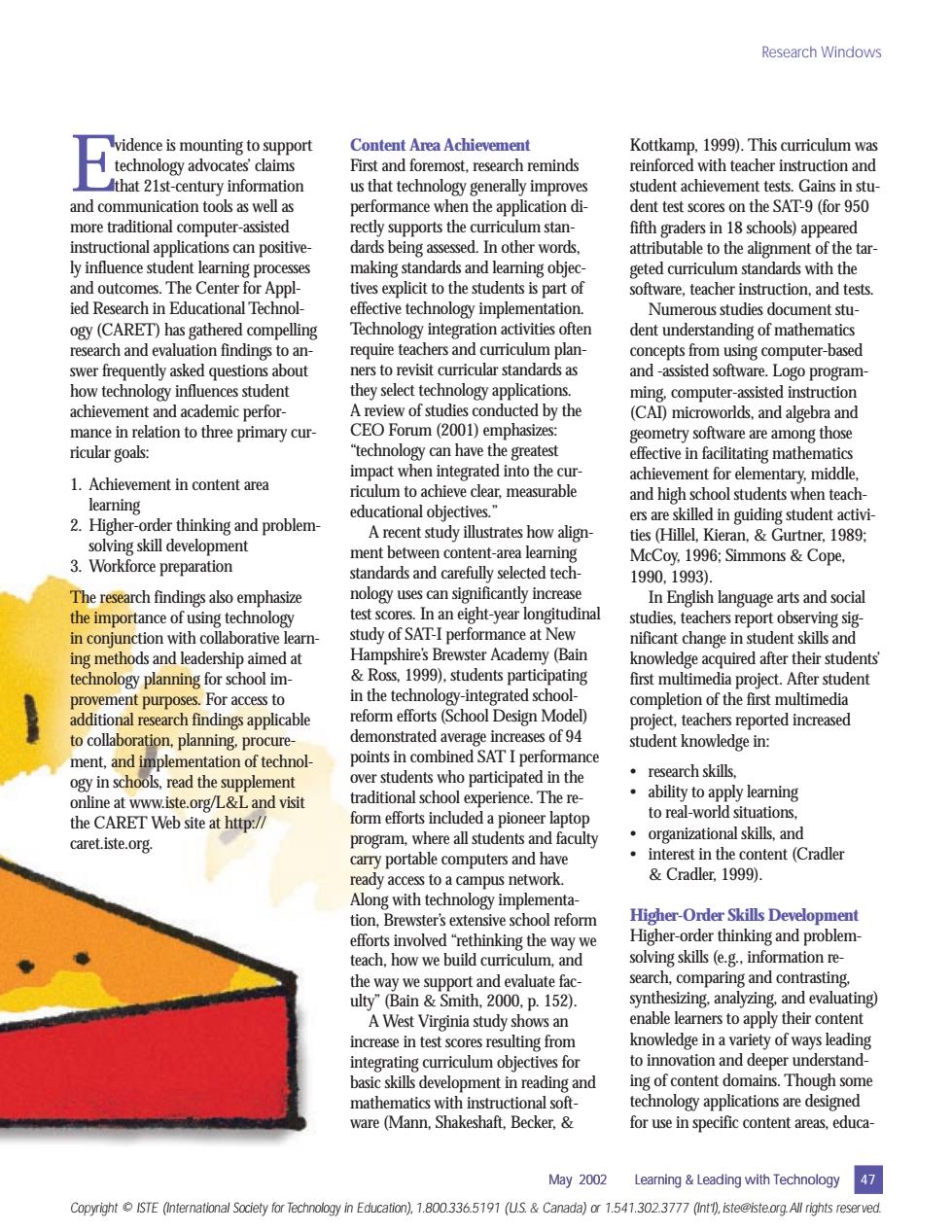正在加载图片...

Research Windows vidence is mounting to support Content Area Achievement Kottkamp.1999).This curriculum was technology advocatesclaims First and foremost.research remind reinforced with teacher instruction and us that techn uppo um sta hools)appe an positive oth attr the alignm a andards o the stud are,te (CARET)has der t un ling of m nd cu ter ently asked ners to revisit curricular standards as cos student they select technol achievement and academic pe A review of studies o mance in relation to three primary cur- CEO Forum (2001)emphasizes ricular goals: "technology can have the greatest impact when integrated into the cu achievement for elementary middl 1.Achievement in content area riculum to achieve clear,measurable and high school students when teach earning 2.Highe educational objecti ers are skilled in guiding student activi order thinking and problem- A recent study ates how ties (Hillel.kieran.Gurtner 1989 solving skill development McCoy.1996:Simmons cope 3.Workforce preparation 1990,1993). The research findings also emphasize tly increas In English language arts and social the importance of using technology es neight-yea studies,teachers report observing sig in conjunction with collaborative I nificant change in student skills and ing methods and leadership aimed at D knowledge acquired after technology planning for school im- 1999).studen their students n the tochnol first multimedia project.After student purpose For access to completion of the first multimedia findings applicable project,teachers reported increased age increases of 94 on,planning.procure student knowledge in points in combined SAT I performance ogy in sc over students who participated in the raditional school and vist at http. form efforts included a pioneer laptop to re ons program.where all students and faculty carry portable computers and have stn the tent (Cradle dy access to a campus network Along with technology implementa tion,Brewster's exter Higher-Order Skills Devel e school reform Higher- order thinking and proble curriculum,ar ving skills (e.g.inf lua h.2000 A152 anal and co ntr and evaluating) A West Virg enable eamers to apply their content knowledge in a va nderstand. and ing of content domains.Though some uctional so technology applications are designed ware (Mann,Shakeshaft,Becker., for use in specific content areas educa. May 00 Leamning&Leading with Technology May 2002 Learning & Leading with Technology 47 Research Windows Evidence is mounting to support technology advocates’ claims that 21st-century information and communication tools as well as more traditional computer-assisted instructional applications can positively influence student learning processes and outcomes. The Center for Applied Research in Educational Technology (CARET) has gathered compelling research and evaluation findings to answer frequently asked questions about how technology influences student achievement and academic performance in relation to three primary curricular goals: 1. Achievement in content area learning 2. Higher-order thinking and problemsolving skill development 3. Workforce preparation The research findings also emphasize the importance of using technology in conjunction with collaborative learning methods and leadership aimed at technology planning for school improvement purposes. For access to additional research findings applicable to collaboration, planning, procurement, and implementation of technology in schools, read the supplement online at www.iste.org/L&L and visit the CARET Web site at http:// caret.iste.org. Content Area Achievement First and foremost, research reminds us that technology generally improves performance when the application directly supports the curriculum standards being assessed. In other words, making standards and learning objectives explicit to the students is part of effective technology implementation. Technology integration activities often require teachers and curriculum planners to revisit curricular standards as they select technology applications. A review of studies conducted by the CEO Forum (2001) emphasizes: “technology can have the greatest impact when integrated into the curriculum to achieve clear, measurable educational objectives.” A recent study illustrates how alignment between content-area learning standards and carefully selected technology uses can significantly increase test scores. In an eight-year longitudinal study of SAT-I performance at New Hampshire’s Brewster Academy (Bain & Ross, 1999), students participating in the technology-integrated schoolreform efforts (School Design Model) demonstrated average increases of 94 points in combined SAT I performance over students who participated in the traditional school experience. The reform efforts included a pioneer laptop program, where all students and faculty carry portable computers and have ready access to a campus network. Along with technology implementation, Brewster’s extensive school reform efforts involved “rethinking the way we teach, how we build curriculum, and the way we support and evaluate faculty” (Bain & Smith, 2000, p. 152). A West Virginia study shows an increase in test scores resulting from integrating curriculum objectives for basic skills development in reading and mathematics with instructional software (Mann, Shakeshaft, Becker, & Kottkamp, 1999). This curriculum was reinforced with teacher instruction and student achievement tests. Gains in student test scores on the SAT-9 (for 950 fifth graders in 18 schools) appeared attributable to the alignment of the targeted curriculum standards with the software, teacher instruction, and tests. Numerous studies document student understanding of mathematics concepts from using computer-based and -assisted software. Logo programming, computer-assisted instruction (CAI) microworlds, and algebra and geometry software are among those effective in facilitating mathematics achievement for elementary, middle, and high school students when teachers are skilled in guiding student activities (Hillel, Kieran, & Gurtner, 1989; McCoy, 1996; Simmons & Cope, 1990, 1993). In English language arts and social studies, teachers report observing significant change in student skills and knowledge acquired after their students’ first multimedia project. After student completion of the first multimedia project, teachers reported increased student knowledge in: • research skills, • ability to apply learning to real-world situations, • organizational skills, and • interest in the content (Cradler & Cradler, 1999). Higher-Order Skills Development Higher-order thinking and problemsolving skills (e.g., information research, comparing and contrasting, synthesizing, analyzing, and evaluating) enable learners to apply their content knowledge in a variety of ways leading to innovation and deeper understanding of content domains. Though some technology applications are designed for use in specific content areas, educaMay 2002 Learning & Leading with Technology 47 Copyright © ISTE (International Society for Technology in Education), 1.800.336.5191 (U.S. & Canada) or 1.541.302.3777 (Int’l), iste@iste.org. All rights reserved